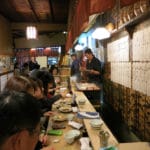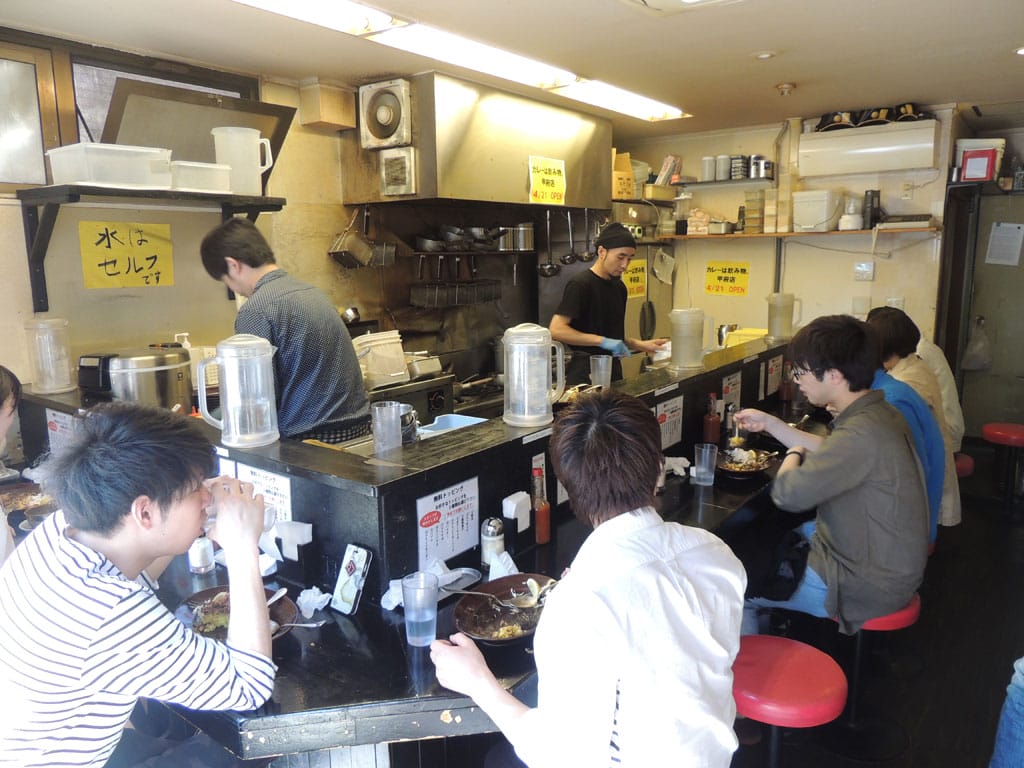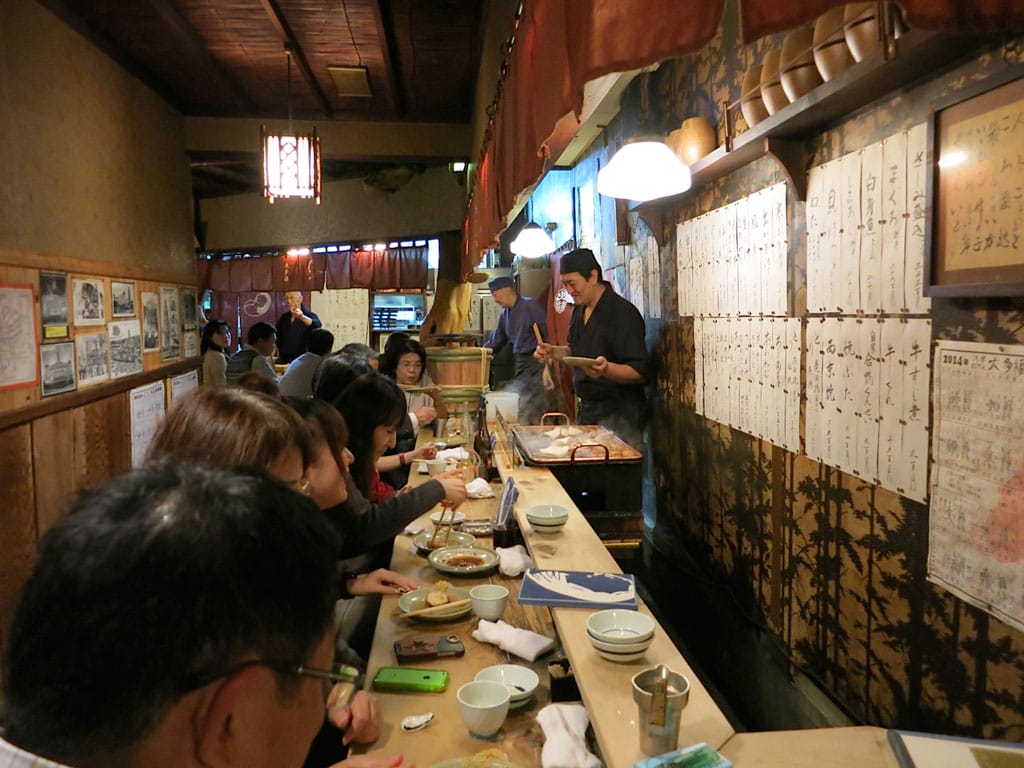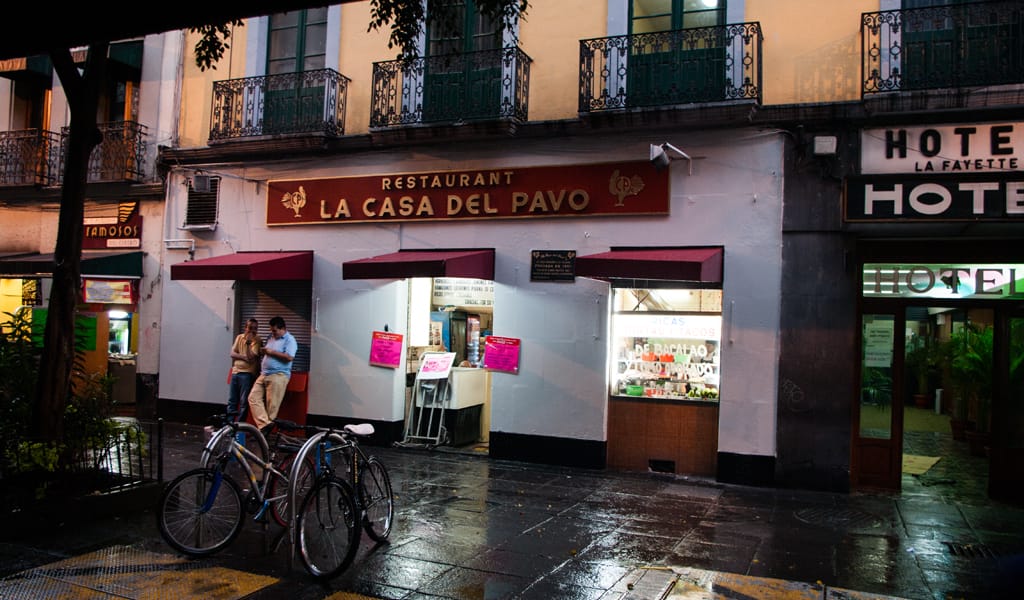There’s a general rule of thumb in Tokyo that if you see a line in front of a restaurant, it’s probably worth standing in. Maybe that’s how we first discovered Karē wa Nomimono. Or maybe it was the heady scent of fresh curry that wafts out the kitchen door before the restaurant opens every day. As many times as we’ve been back, it’s hard to remember.
The British Navy first introduced curry to Japan sometime at the end of the 19th century. Unlike its South and Southeast Asian counterparts, Japanese curry is thickened with roux and made from curry powder rather than blended spices. The result is a generally mild but hearty flavor with a thick and satisfying texture. Touted as a national dish since at least the mid-20th century, curry rice is for many Japanese the quintessential comfort food. While some shops pride themselves on making curry just like mom used to, others are taking the classic dish in bold new directions.
Karē wa Nomimono, which translates roughly to “Curry is a Drink,” splashed on to the scene in 2012 in Ikebukuro, though they’ve since opened a second location in Akihabara. They only serve two kinds of curry, red and black. The red is tomato based with chicken, and while it resembles a more Indian-style curry, the taste is somewhat reminiscent of an Italian stew. Bottles of both hot sauce and parmesan cheese placed on the counter suggest this convergence isn’t accidental. The more popular black curry (it obtains its dark shade from the spices used) hews closer to the traditional Japanese flavor profile, but won’t fail to surprise even the most seasoned curry hound.
 Despite the limited menu, diners can visit the shop 100 times and never have the same meal twice. Each plate of curry served is fully customizable, as diners choose three toppings from a list of 10. These include traditional curry sides like Japanese shallots (#2), as well as much stranger pairings like tuna mayo (#7). On our most recent visit, we broke from our customary potato salad (#4) and corn mayo (#8) to try pickled vegetables (#3) and cilantro (#6). Our perennial favorite, fried onions (#10), rounded out our selection. The list of toppings is in Japanese only, and for the adventurous eater and non-native speaker, that can be part of the fun.
Despite the limited menu, diners can visit the shop 100 times and never have the same meal twice. Each plate of curry served is fully customizable, as diners choose three toppings from a list of 10. These include traditional curry sides like Japanese shallots (#2), as well as much stranger pairings like tuna mayo (#7). On our most recent visit, we broke from our customary potato salad (#4) and corn mayo (#8) to try pickled vegetables (#3) and cilantro (#6). Our perennial favorite, fried onions (#10), rounded out our selection. The list of toppings is in Japanese only, and for the adventurous eater and non-native speaker, that can be part of the fun.
After a 15-minute wait, we were seated at the L-shaped counter, which can accommodate nine diners at a time. Within minutes of choosing our toppings, we were handed a heavy plate. Tender hunks of slow cooked pork and stewed daikon swam in the rich black curry, so thick it hardly penetrated the bed of saffron rice beneath. Karē wa Nomimono is about quality and quantity, and enjoying the massive portions here is a practiced art. Eyes wide and mouth watering, we deftly scooped warm bites of curry rice up from the plate. We missed the cool feel of the potato salad against the piping curry, but the flavorful tang of coriander and pickles was a piquant surprise.
 At long last we slid off our stool and ambled sluggishly outside. Normally in such a state food would be the last thing on our mind, but we were already thinking about what new combination of toppings to try on our next visit. Perhaps we’ll have to give the newest addition to the list, fried garlic (#5), a try. Karē wa Nomimono opens at 11:30 for lunch and 5:00 for dinner, and closes when they run out of food. In our experience that doesn’t take long.
At long last we slid off our stool and ambled sluggishly outside. Normally in such a state food would be the last thing on our mind, but we were already thinking about what new combination of toppings to try on our next visit. Perhaps we’ll have to give the newest addition to the list, fried garlic (#5), a try. Karē wa Nomimono opens at 11:30 for lunch and 5:00 for dinner, and closes when they run out of food. In our experience that doesn’t take long.
 April 1, 2024 Pastiera
April 1, 2024 Pastiera
Like the Proustian madeleine, sweets can stir up all kinds of feelings in the minds of […] Posted in Naples January 15, 2024 Otafuku
January 15, 2024 Otafuku
The weather is turning cold and Japan’s convenience stores, or konbini, have hauled out […] Posted in Tokyo November 24, 2023 La Casa del Pavo
November 24, 2023 La Casa del Pavo
The bird that holds pride of place at the Thanksgiving table has just as important a […] Posted in Mexico City
Published on May 18, 2016
Related stories
April 1, 2024
NaplesLike the Proustian madeleine, sweets can stir up all kinds of feelings in the minds of those who eat them. In Naples, struffoli (small, round doughnuts glazed with honey) and cassata (sponge cake with ricotta and candied fruit) speak of Christmas, while chiacchiere (sugar-dusted fritters) and sanguinaccio (literally “blood pudding,” but actually made of chocolate)…
January 15, 2024
TokyoThe weather is turning cold and Japan’s convenience stores, or konbini, have hauled out the oden service pans and positioned them next to the cashier counters. For those not familiar with oden, the sight of assorted flotsam and jetsam afloat in a clear broth and the fishy aroma impinging on their space while paying for…
November 24, 2023
Mexico CityThe bird that holds pride of place at the Thanksgiving table has just as important a role south of the border. Turkey has actually been a fundamental part of Mexican cooking for centuries: The Aztecs had domesticated the fowl before they had even laid eyes on a chicken. And while chicken has since overtaken turkey…


















































































